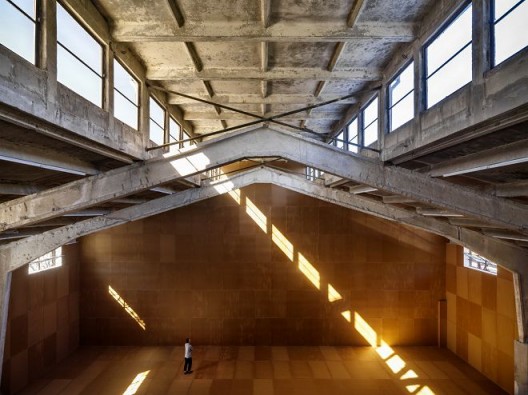Galleria Continua (Dashanzi Art District 798 2 Jiuxianqiao Road, Chaoyang District Beijing), Sept 28, 2016-Feb 5, 2017
A remarkable casualness permeates Kiwon Park’s latest solo exhibition at Galleria Continua: the audience need not worry about being warned against leaning too close to the artworks by the guards, nor is there a need for parents to stop their children from touching them. In the exhibition “Hidden Surface,” apart from instructions to take off their shoes and to not deliberately cause any damage, people are welcome to freely interact with “Thickness”, a work integrated into the space of the main gallery. Here, thousands of pieces of cardboard equal in size pave the entire floor and the surrounding walls, leaving only the cement-colored ceiling and four pillars that heave from the walls untouched. Some audiences might label “Thickness” “minimalist” when they step into this “blank” space, but the work certainly does not lay its sole emphasis on the materiality of its production.
Before mounting the cardboard onto the walls, Kiwon Park and his assistants applied a translucent oil-based paint to their surface. The manual brushwork involved meant uneven bleeding into the paper coating, resulting in different shades of color on the surface of the panels. On the whole, this subtle treatment adds more rhythm to the cardboard’s surface than if it had retained its original color; meanwhile, it also offsets the regularity and inflexibility of its rectangular shapes, as well as the coldness of the gallery’s existing structure. Walking into the work, one can perhaps imagine what tedious labor it must have been to wave one’s arms over hundreds of pieces of cardboard and apply translucent paint to them. This act of “painting” does not require any extraordinary skills, nor does it intend to outline any specific shapes. The repetitive movement is as ordinary as any everyday task, and the creative process is essentially a record of the artist’s everyday experience and his dialogue with the work which, layer upon layer, has bled into the material.
Integrated into the gallery space, “Thickness” does not cease growing at the moment of its completion, but instead continues to live in its new environment and through its visitors. In autumn, the humid morning air and the warm afternoon sunlight pass through a row of windows at ceiling height. After a few days, the flat surfaces of the cardboard panels began to corrugate slightly. On a clear day, sunlight enters the space and adds to “Thickness” a bright stroke that moves and morphs with the rise and fall of the sun.
“Thickness” has transformed the main exhibition hall into somewhere as banal as a common room, a training room, or a storage space. Walking into it, visitors are encouraged by the work to act at will: they pace up and down the room, whisper to each other, or even start to dance. Compared to works that attempt to imitate the real world or serve as a metaphor for it, Kiwon Park’s maneuvers with the sensibilities of space, surface, color, and light open up new interpretations for his work.





